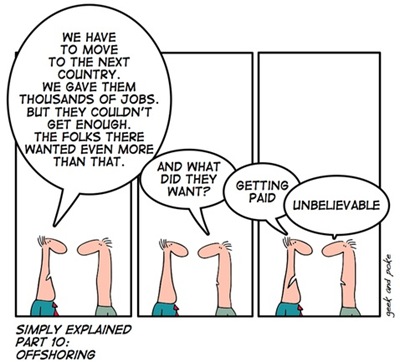One of the most important uses of capital is in discovering new markets. With a sufficient pool of capital, new markets can be quickly discovered, probed and exploited; the viable markets invite a rash of competing companies, and unviable markets are neglected and wither.
In India, most companies are severely capital-deprived. With the increases in FDI in recent years, this has changed for the better, but the process of market discovery is still slow and, by and large, left to large companies.
This capital deprivation is one of the reasons that a few large companies are spread across many unrelated markets in India – for example, the Tatas in broadband (Tata Indicom), mobile (Tata Docomo), power distribution (Tata Power in Mumbai), and even electronics retail (Croma).
One of the best features of the American economy is that capital is available to both small and large companies – small companies often doing the work of finding new profitable market niches, and going on to become (or selling out to) larger companies.
In India though, the lack of capital means that most small companies have to think constantly of ways to survive before it becomes possible to sustain the company through cash flows from their primary product.
Some markets require large amounts of capital before it can be said with any certainly whether they are viable or not. In the book "Founders at Work", the founder of Tivo – probably one of the more disruptive products of the last few decades – mentions that it took about $500 million in funding in its first few years. This is an unimaginable amount of money for a small company (or even a medium-sized) company in India to spend, although in the case of Tivo at least, I think the jury is still out on whether this is a viable market or not.
The example of Amazon – which spent several years taking investor money before it turned profitable – is also well known.
These examples – of large capital expenditures before a market is proven – are unlikely to repeat themselves in India since the pool of capital is limited, and flows mainly to large companies. Large companies are typically conservative about exploring unproven markets, since there are multiple internal constituencies that have to be convinced before such projects are green-lighted.
Given this situation of capital scarcity, especially for early stage companies, what is the best strategy for startups to survive?
One is, as mentioned above, to copy products that have worked somewhere else. These have the nice property that you know that someone, somewhere, is willing to pay for that product, and it is also fairly clear how much money is needed to produce it. Companies following this strategy have to be careful that the original product itself won’t be available in their target market before they are ready. For example, making an Indian version of Facebook at this point is probably a poor bet, since the original product has considerable traction. Countries such as China or Germany that have language barriers have seen domestic knockoffs of popular international Web applications before those products were localized into their domestic languages.
Another strategy is to bootstrap the company by doing work for hire. This is a well-established path, and intermediaries like Elance, Rent a Coder and oDesk make it possible to get contract work that (at least in theory) can pay for the salaries of the people working on the "real" product.
In practice, I believe it is all too easy to become a full fledged outsourcing company, and lose sight of the original product. This is fine as far as it goes, but a service company lacks the advantages of leverage that a product startup naturally has. (See my previous post for more on this.)
An additional option, which I believe more and more companies in India will adopt, is to conceive and develop a product in India for the international market.
While examples of US companies that develop their entire product in India while targeting the US market are now commonplace, these companies are typically American companies with American (or Indian-American) founders.
Companies created by Indians in India have traditionally focused on the market at their doorstep before venturing abroad. In some cases, especially for technology products, the Indian market may take several years to become large enough to support Indian startups. In such cases, it makes sense to target global markets side by side with, or sometimes even before, the Indian market.
This "global from day 1" attitude is probably most evident in companies from Israel, as well as other small European countries that lack a large home market. For products where the Indian market is more similar in size to, say, Belgium, than the US, it may make a lot of sense for Indian companies to think international from the start.
[This post is authored by Abhijeet Vijayakar - founder of Nunook Interactive Pvt Ltd, a game startup in Mumbai and Chennai. Nunook is currently developing BrainNook, India's first online, educational virtual world for kids, parents and teachers. In a previous life, Abhijeet developed 3D graphics engines (and games) at Electronic Arts in the San Francisco Bay Area. He highly recommends not succumbing to capital deprivation syndrome.]

 I’ve added a weekend post routine that I hope you enjoy. Each weekend I write a post that features 3-4 things I read during the week that I found interesting. Generally speaking it won’t involve much analysis and may range widely in topic. (Flickr image included here is also fav image of the week)
I’ve added a weekend post routine that I hope you enjoy. Each weekend I write a post that features 3-4 things I read during the week that I found interesting. Generally speaking it won’t involve much analysis and may range widely in topic. (Flickr image included here is also fav image of the week)




